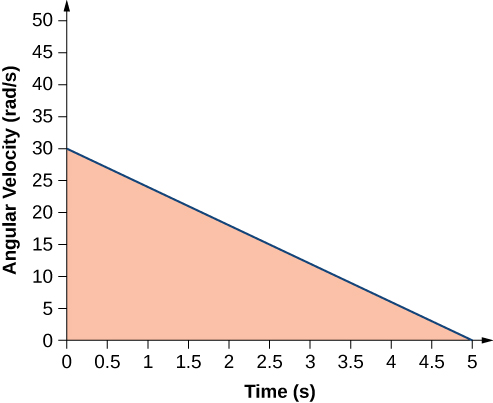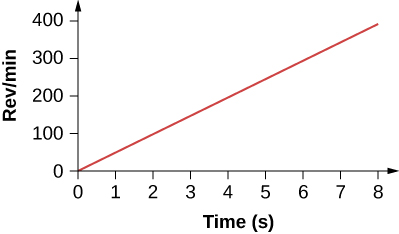| << Chapter < Page | Chapter >> Page > |

If a rigid body has a constant angular acceleration, what is the functional form of the angular velocity in terms of the time variable?
straight line, linear in time variable
If a rigid body has a constant angular acceleration, what is the functional form of the angular position?
If the angular acceleration of a rigid body is zero, what is the functional form of the angular velocity?
constant
A massless tether with a masses tied to both ends rotates about a fixed axis through the center. Can the total acceleration of the tether/mass combination be zero if the angular velocity is constant?
A wheel has a constant angular acceleration of . Starting from rest, it turns through 300 rad. (a) What is its final angular velocity? (b) How much time elapses while it turns through the 300 radians?
a.
;
b.
During a 6.0-s time interval, a flywheel with a constant angular acceleration turns through 500 radians that acquire an angular velocity of 100 rad/s. (a) What is the angular velocity at the beginning of the 6.0 s? (b) What is the angular acceleration of the flywheel?
The angular velocity of a rotating rigid body increases from 500 to 1500 rev/min in 120 s. (a) What is the angular acceleration of the body? (b) Through what angle does it turn in this 120 s?
a.
;
b.
A flywheel slows from 600 to 400 rev/min while rotating through 40 revolutions. (a) What is the angular acceleration of the flywheel? (b) How much time elapses during the 40 revolutions?
A wheel 1.0 m in diameter rotates with an angular acceleration of . (a) If the wheel’s initial angular velocity is 2.0 rad/s, what is its angular velocity after 10 s? (b) Through what angle does it rotate in the 10-s interval? (c) What are the tangential speed and acceleration of a point on the rim of the wheel at the end of the 10-s interval?
a.
;
b.
; c.
A vertical wheel with a diameter of 50 cm starts from rest and rotates with a constant angular acceleration of around a fixed axis through its center counterclockwise. (a) Where is the point that is initially at the bottom of the wheel at (b) What is the point’s linear acceleration at this instant?
A circular disk of radius 10 cm has a constant angular acceleration of ; at its angular velocity is 2.0 rad/s. (a) Determine the disk’s angular velocity at . (b) What is the angle it has rotated through during this time? (c) What is the tangential acceleration of a point on the disk at
a.
;
b.
; c.
The angular velocity vs. time for a fan on a hovercraft is shown below. (a) What is the angle through which the fan blades rotate in the first 8 seconds? (b) Verify your result using the kinematic equations.

A rod of length 20 cm has two beads attached to its ends. The rod with beads starts rotating from rest. If the beads are to have a tangential speed of 20 m/s in 7 s, what is the angular acceleration of the rod to achieve this?
.

Notification Switch
Would you like to follow the 'University physics volume 1' conversation and receive update notifications?